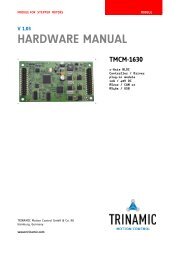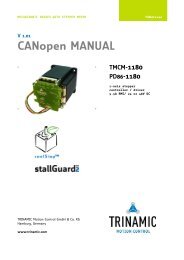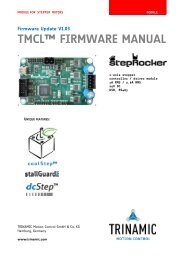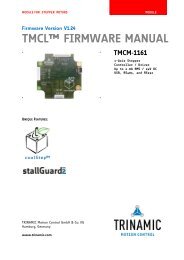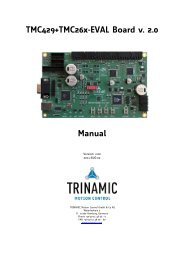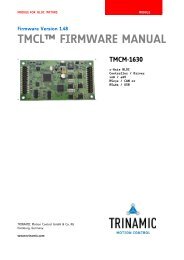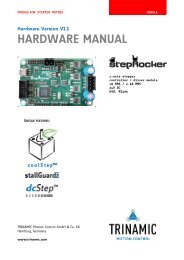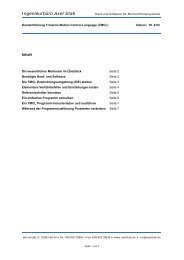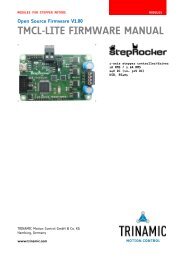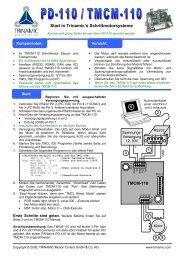TMC428 – Application Note - Trinamic
TMC428 – Application Note - Trinamic
TMC428 – Application Note - Trinamic
Create successful ePaper yourself
Turn your PDF publications into a flip-book with our unique Google optimized e-Paper software.
<strong>TMC428</strong> <strong>–</strong> <strong>Application</strong> <strong>Note</strong> <strong>–</strong> <strong>TMC428</strong> Getting Started <strong>–</strong> Including StallGuard TM 6<br />
(v. 2.00 / April 14, 2008)<br />
2.3 Parameterizing Individual Stepper Motors<br />
Each stepper motor has its associated set of registers for motion control. Before running a motor,<br />
some parameters have to be initialized once. For many applications, there is no need to re-program<br />
settings done once during initialization. Once initialized, the motion control becomes quite easy. For<br />
ramp_mode the micro controller just sends desired target positions and the <strong>TMC428</strong> autonomously<br />
takes care of positioning. For velocity_mode, the micro controller just sends the desired target velocity<br />
to the <strong>TMC428</strong> to run a stepper motor continuously.<br />
On first sight, the determination of the required parameters might look a little bit complicated but it is<br />
simple. These parameters allow the adjustment to a very wide range of applications. The motion<br />
control parameters are represented as integer resp. signed integer values within units that are specific<br />
for the <strong>TMC428</strong> depending on the clock frequency used for the <strong>TMC428</strong>.<br />
From the stepper motor application point of view, motion control parameters within units of full steps<br />
(FS) for position, full steps per second (FS/s) for velocity, and full steps per second square (FS/s^2) for<br />
acceleration are natural units for stepper motors. The formulas to calculate into these units are given<br />
within the <strong>TMC428</strong> data sheet section pulse_div & ramp_div & usrs (IDX=%1100)). A spread sheet<br />
named 'tmc428_frequencies.xls' that calculates between physical motion units (rad, rad/s, …)<br />
and stepper specific units (FS, FS/s, …) and a stand-alone program '<strong>TMC428</strong>Calc.exe' are<br />
available on www.trinamic.com<br />
2.2.1 Velocity R[Hz] and Acceleration R[Hz/s]<br />
The desired micro step frequency R[Hz] and the desired R[Hz] micro step acceleration depend on the<br />
application. Typical stepper motors can go up to full step frequencies of some thousand full steps per<br />
second. Without load, they can accelerate to those full step frequencies within a couple of full steps.<br />
2.2.1.1 Choosing Micro Step Resolution / Step Pulse Pre-Divider / Acceleration Pre-Divider<br />
First, one has to choose the micro step resolution. Following, the highest micro step resolution is<br />
chosen be setting usrs = 6. Then, the pulse pre-divider has to be determined. It allows to scale the<br />
step frequencies in a very wide range. Based on the formula R[Hz] = f_clk[Hz] * velocity / ( 2^pulse_div<br />
* 2048 * 32 ) given within the <strong>TMC428</strong> datasheet one can determine<br />
pulse_div := log( f_clk[Hz] * v_max / ( R[Hz] * 2048 * 32 ) ) / log(2)<br />
setting v_max = 2047 (resp. 2048 for simplified calculation) and R[Hz] to the maximum desired micro<br />
step frequency. The full step frequency can be calculated based on the formula RFS[Hz] = R[Hz] /<br />
2^usrs given within the <strong>TMC428</strong> data sheet. With this, the micro step frequency is R[Hz] = RFS[Hz] *<br />
2^usrs. The quotient of logarithms comes from the relation log2(x) = log(x) / log(2) to calculate the<br />
logarithm to the basis of two which is the number of bits need to represent x. The calculation result of<br />
pulse_div then has to be chosen close to the next integer value.<br />
After determination of pulse_div, the parameter ramp_div can be calculated. Based on the formula<br />
R[Hz/s] = f_clk[Hz] * f_clk[Hz] * a_max / ( 2^(pulse_div+ramp_div+29) ) given within the <strong>TMC428</strong><br />
datasheet one can determine<br />
ramp_div := log( f_clk[Hz] * f_clk[Hz] * a_max / ( R[Hz/s] * 2^(pulse_div+29) ) ) / log(2)<br />
setting a_max = 2047 (resp. 2048 for simplified calculation) and R[Hz/s] to the maximum desired<br />
micro step acceleration. The calculation result of ramp_div then has to be chosen close to the next<br />
integer value.<br />
Copyright © 2005-2008 TRINAMIC Motion Control GmbH & Co. KG



